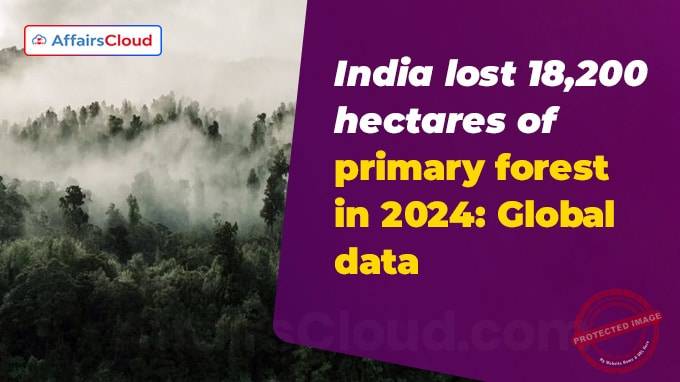
As per the latest data released in May 2025 by the Global Forest Watch (GFW), an international collaboration of more than 100 organisations, India lost 18,200 hectares (ha) of primary forest in 2024 compared to 17,700 ha lost in 2023.
- The data further revealed that India lost 3,48,000 ha or 348 kilo hectare (kha) of humid primary forest between 2002 and 2024, accounts about 5.4% of the country’s total humid primary forest. This figure also represents 15% of India’s total tree cover loss during the same period.
- Globally, 2024 witnessed unprecedented forest loss, largely driven by massive fires. The tropics alone lost a record 6.7 million ha of primary rainforest.
Monitoring Methodology:
i.This data is provided by GFW,an initiative of the United States of America(USA) based World Resources Institute(WRI) in collaboration with the USA based University of Maryland.
ii.GFW identifies primary forests using satellite imagery from the Landsat program, combined with region-specific algorithms tailored to detect and monitor forest cover changes.
iii.GFW has defined primary forests as mature natural humid tropical forests that have not been completely cleared and regrown in recent history.
iv.These forests are identified using Landsat satellite images and special algorithms for each region.
Key Findings:
i.As per the data, India has lost 2.31 million ha (Mha) of tree cover since 2001, equivalent to a 7.1% decrease in tree cover during this period and 1.29 Gigatonnes of Carbon Dioxide equivalent emissions (GtCO2e).
ii.GFW’s data showed that India lost 103 kha (1.6%) of humid primary forest between 2019 and 2024; accounts 14% of its total tree cover loss in those years.
- India lost its primary forest cover between 2019 and 2022: 14,500 ha (in 2019), 17,000 ha (in 2020), 18,300 ha (in 2021), and 16,900 ha (in 2022).
iii.Despite witnessing decline in tree cover, India recorded an increase of 1.78 Mha of tree cover between 2000 and 2020, marking about 1.4% of the global total increase.
iv.India lost total 36.2 kha of tree cover from fires from 2001 to 2024. Year 2008 recorded the most tree cove loss due to fires, with 2.77 kha (3.5%) lost to fires.
- The data showed that top 4 regions in India accounted for 52% of all tree cover loss between 2001 and 2024. Assam recorded the highest tree cover loss at 340 kha between 2001 and 2024, compared to the national average of 67,900 ha during the same period.
- It was followed by Mizoram (334 kha), Nagaland (269 kha), Manipur (255 kha) and Meghalaya (243 kha).
v.The report highlighted main reasons/factors which contributed in the loss of tree cover between 2001 and 2024: shifting cultivation (1.39 Mha), permanent agriculture (620 kha), logging (182 kha), natural disturbances (35,100 ha) and settlements & infrastructure development (30,600 ha).
Other Key Points:
i.As of 2010, top 7 regions in India account 51% of all tree cover in the country. Assam had the most tree cover at 2.75 Mha, which is higher than the national average of 817kha.
- It was followed by Chhattisgarh (2.28 Mha), Kerala (2.28 Mha) and Odisha (1.92 Mha) and Karnataka (1.88 Mha).
ii.India witnessed a net change of 874 kha (1.3%) in tree cover from 2000 to 2020.
iii.The data revealed that as of 2000, around 10% (32.6 Mha)of India land cover was tree cover with less than 30% canopy density.
Note: As per Rome (Italy)-based United Nations (UN) Food and Agriculture Organisation (FAO), India had the 2nd highest rate of deforestation in the world between 2015 and 2020, losing nearly 6.68 lakh ha of forest annually. Brazil topped the list, with an average annual forest loss of about 1.7 million hectares.
About Global Forest Watch (GFW):
It is an initiative of World Resources Institute (WRI) launched in 2014 in partnership with Google, United States Agency for International Development (USAID), among others.




